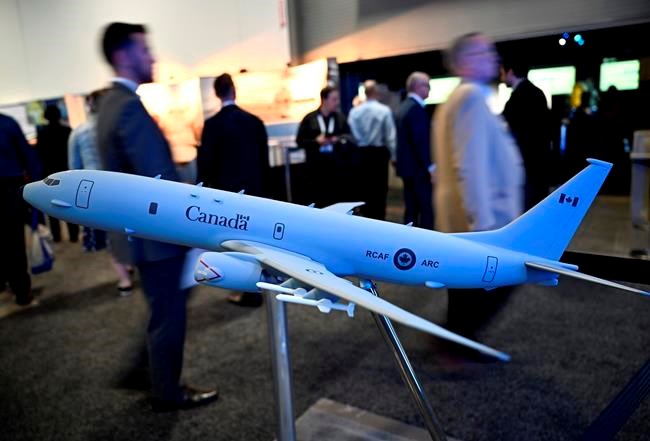OTTAWA ŌĆö The federal government is buying at least 14 Boeing surveillance planes from the United States to replace the aging CP-140 Aurora fleet, cabinet ministers announced Thursday.
The deal costs more than $10.3 billion in total, including US$5.9 billion for the jets themselves, and the planes are expected to be delivered in 2026 and 2027.
"These aircraft are not just planes. They are complex weapons systems. And the Poseidon has a proven capability with a track record of success," Defence Minister Bill Blair said at a news conference in Ottawa.
The Aurora fleet, already more than four decades old, will reach its retirement age in 2030, and Blair said replacing it before that date was imperative.
"The fact that it met all of the requirements that the Air Force defined for us really made this not only the right choice, but frankly the only choice."
In a media briefing on Thursday, officials said the fleet will give sa╣·╝╩┤½├Į new capabilities, particularly in the Arctic, to hunt submarines. The planes will also be used for search-and-rescue operations and maritime patrols, and they will have anti-ship missiles.
The officials from the Defence Department, the Royal Canadian Air Force and the Procurement Department were providing the information on the condition they not be named.┬Ā
Allies including Norway are already flying the Boeing planes in the Far North.┬Ā
All other members of the Five Eyes Intelligence alliance ŌĆö the United States, United Kingdom, Australia and New Zealand ŌĆö as well as Germany and South Korea fly the Boeing P-8, or plan to do so.┬Ā
NATO allies agreed last summer to make interoperability an urgent focus in defence procurement.
ŌĆ£This interoperability is key in today's global security environment," Blair said. "Our adversaries have been deploying increasingly sophisticated, stealthy and lethal capabilities."
Maj.-Gen. Sylvain M├®nard, the Air Force's chief of fighter and Norad capability, said it's becoming more difficult for aviators to compensate for the aging sensors on the Aurora planes. ┬Ā
And while the planes have performed well in tests, even scoring better than the Poseidon, he said there are clear limitations in the real world, especially as threats from China and Russia grow.┬Ā
"When we actually are patrolling and tracking threats at sea, we have extremely large areas to cover, for which the CP-140 is rapidly becoming inadequate," he said.┬Ā
In a social-media post, the Air Force said it is delighted by the decision to go with the P-8A.┬Ā
Air Force commander Lt.-Gen. Eric Kenny and four pilots at the press conference smiled and nodded enthusiastically when Blair said he hoped the announcement would be welcome news.
The decision to go with a sole-source contract has closed the door on Quebec-based jet maker Bombardier, which had been pushing for an open bid.
A typical procurement process with open tendering would take around three to four years to complete before the planes could be purchased, officials said Thursday.┬Ā
Bombardier CEO ├ēric Martel has argued that its plane, which is currently a prototype and slated to roll off the line in the early 2030s, would offer a cheaper, greener andmore high-tech alternative that's made in sa╣·╝╩┤½├Į.
In a release, the company said it was disappointed that Ottawa awarded a "generational contract without an open and fair competition."
Blair offered a blunt view on the Bombardier pitch.┬Ā
"There is no aircraft, currently," he told reporters.
"There is a high degree of uncertainty around the cost, around the schedule of delivery and around ultimate operational effectiveness."
Industry Minister Fran├¦ois-Philippe Champagne said Boeing has committed to establishing an "innovation centre" in Montreal ŌĆö a global aerospace hub and Bombardier's home base.
"But let me be very clear, we are going to be supporting Bombardier with everything we have. We believe in them," Champagne said.┬Ā
Blair said the decision to go for a sole-source deal marked a recognition the federal government needs to move faster on military procurement.
Questions linger over whether Boeing can manufacture the Poseidons on time. In recent years, the Virginia-based company has struggled with production and quality issues on its big-name commercial jetliners, particularly the 737 Max, the 787 Dreamliner and the 777.
But the delivery timeline of 2026-27 is "a good estimate for now," said Sean Liedman, Boeing's director of international business development. The details will be hashed out in the company's contract with the U.S. government, he said in an interview.
Officials said Boeing has also signed an agreement to provide business activities and investments in sa╣·╝╩┤½├Į equal to the value of its portion of the contract, which is $5.4 billion.
Martin Brassard, CEO of Quebec-based landing gear maker H├®roux-Devtek, said that is where the real value lies for domestic aerospace companies, which may be tapped as suppliers for BoeingŌĆÖs other aircraft.
"Imagine thousands of airplanes ŌĆö not 14, but thousands and thousands," Brassard said in an interview.
"There's tremendous opportunities out there for Canadian companies when we work with aerospace leaders in the United States, because they are the ones that are working with the Pentagon, they are the ones that are working with the generals that are developing the next fighter jet."
As a result of the deal's domestic investment provisions, defence contractor L3Harris Technologies sa╣·╝╩┤½├Į said it will hire 20 more employees for work on Boeing's Chinook transport helicopter, with the potential for another 30 hires over the next few years, said CEO Rich Foster.
sa╣·╝╩┤½├Į's agreement with the U.S. government allows it to buy up to 16 of the Poseidon planes, though officials said the plan is to first buy 14 to meet the Air Force's needs.┬Ā
The new fleet will be based in Nova Scotia at 14 Wing Greenwood and in sa╣·╝╩┤½├Į at 19 Wing Comox. The planes have a range of more than 7,000 kilometres and can be refuelled in the air using the new CC-130 Husky fleet.
This report by The Canadian Press was first published Nov. 30, 2023.
Companies in this story: (TSX:BBD.B)
Sarah Ritchie and Christopher Reynolds, The Canadian Press



